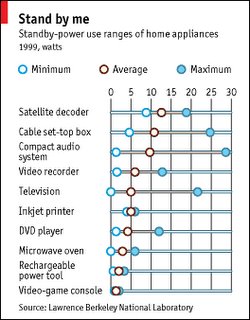Pulling the Plug on Standby Power
STRANGE though it seems, a typical microwave oven consumes more electricity powering its digital clock than it does heating food. For while heating food requires more than 100 times as much power as running the clock, most microwave ovens stand idle—in “standby” mode—more than 99% of the time.Amazing. Possibly 10% of electricity is used by devices really doing nothing. Seems like a no brainer if you want to reduce electricity usage to go after this. If standby power accounts for that much usage, why doesn't someone do something about it?
Alan Meier's results, published in 2000, revealed that standby power accounted for as much as 10% of household power-consumption in some cases. That same year, a similar study in France found that standby power accounted for 7% of total residential consumption. Further studies have since come to similar conclusions in other developed countries, including the Netherlands, Australia and Japan. Some estimates put the proportion of consumption due to standby power as high as 13%.
The problem, as Dr Meier noted way back in 1998, is that there is very little incentive for manufacturers to make devices with low standby-power consumption. And even when they do, there is no easy way for consumers to distinguish between power-hungry devices and more abstemious ones.That is always a tough nut to crack. Looks like the way to go after this is labeling and government regulation. So what is going on?
In 2005 the scheme was extended to external power adapters, which can earn Energy Star approval if they consume less than 0.75W in “no load” mode.Hopefully these will help to reduce the problem.
In late 2004 the California Energy Commission went even further by imposing limits on standby power-consumption for various consumer-electronic devices, including DVD players, external power adapters and stereos. This legislation took effect in January, so that it is now illegal in California to sell a television or DVD player that consumes more than three watts in standby mode.
via Economist.com






No comments:
Post a Comment
Note: Only a member of this blog may post a comment.